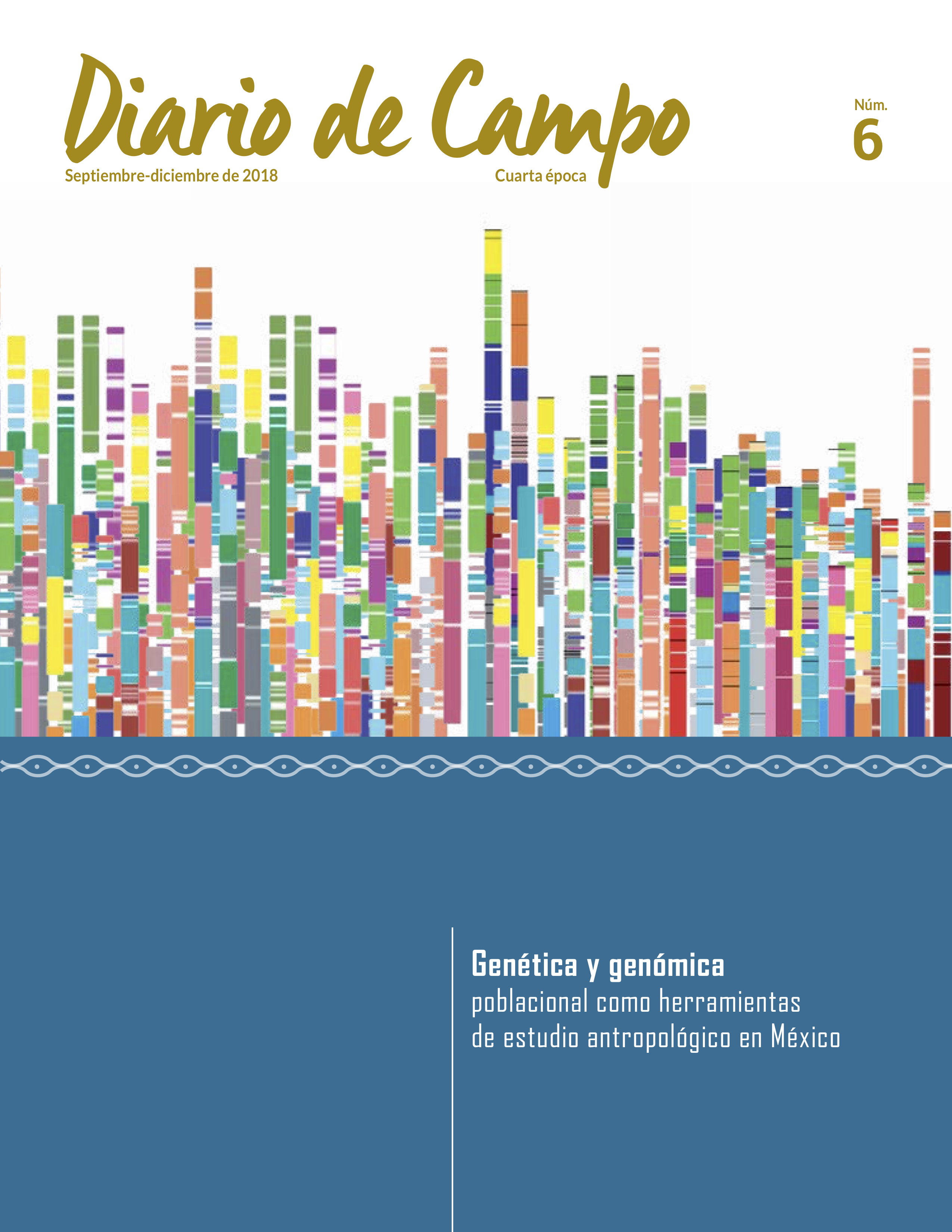Enfoques
Heritability of Obesity in Northeastern Mexico: A Study Based on Dyad (Mother-Child) Body Mass Index
Published 2020-04-01
Keywords
- Heritability,
- Obesity,
- Homogeneity,
- México
How to Cite
Heritability of Obesity in Northeastern Mexico: A Study Based on Dyad (Mother-Child) Body Mass Index. (2020). Diario De Campo, 6, 38-45. https://revistas.inah.gob.mx/index.php/diariodecampo/article/view/15596
Abstract
The aim of this quantitative genetic study was to estimate heritability (h2) of BMI in 2840 mother-child pairs to know if h2 values differ among five states of northeastern Mexico. The total h2 found among states was 51.6% and no significant differences were found among them (X2 = 5.24, p = 0.26). In conclusion, from a genetic epidemiology point of view, genome wide scan association studies can be carried out to find candidate genes in any of these Mexican populations not only for obesity (OB), but also other multifactorial diseases.
Downloads
Download data is not yet available.
References
- Alcalde-Rabanal, Jacqueline Elizabeth et al. (2018). “The complex scenario of obesity, diabetes and hypertension in the area of influence of primary healthcare facilities in Mexico”. PLoS One. 13 (1), e0187028. doi: 10.1371/journal.pone.0187028
- Barquera, Simón y White, Mariel (2018). “Treating obesity seriously in Mexico: Realizing, much too late, action must be immediate”. Obesity Research, 26 (10), pp. 1530-1531.
- Bastarrachea, Raúl et al. (2007). “Heritability and genetic correlations of metabolic disease-related phenotypes in Mexico: Preliminary report from the GEMM Family Study”, Human Biology, 79 (1), pp. 121-129.
- Calderón-Garcidueñas, Ana Laura et al. (2008). “Genetic structure of Mexican mestizo women with breast cancer based on three STR loci”. Human Biology, 20 (2), pp. 191-193.
- Candelero-Juárez, Yadira et al. (2016). “Mínima contribución genética de la obesidad y mínima concordancia entre la percepción materna del peso del hijo (PMPH) con el estado nutricio en Tabasco, México”.Medicina de Torreón, 8 (2), pp. 16-19.
- Center for Disease and Control Prevention. Overweight and Obesity (mayo, 2018). Recuperado de: https://www.cdc.gov/obesity/index.html
- Cerda-Flores, Ricardo Martín et al. (2002). “Maximum likelihood estimates of admixture in Northeastern Mexico using 13 short tandem repeat loci”, American Journal of Human Biology, 14 (4), pp. 429-439.
- _____ (2004). “Epidemiologia genética de la obesidad en el noreste de México. Estimación de la heredabilidad en adolescentes”, Revista de Investigación Clínica, 56 (6), pp. 804-805.
- _____ (2013). “Genetic structure of Mexican Mestizos with type 2 diabetes mellitus based on three STR loci”,Gene, 525 (1), pp. 41-46.
- Dávila-Rodríguez, Martha I. et al. (2005). “Epidemiología genética de la obesidad en el noreste de México. Búsqueda de familias nucleares informativas”, Gaceta Médica de México, 141 (3), pp. 243-246.
- Del Río-Navarro, Blanca E. et al. (2004). “The high prevalence of overweight and obesity in Mexican children”, Obesity Research, 12 (2), pp. 215-223.
- Di Bonaventura, Marco et al. (2018). “Obesity in Mexico: prevalence, comorbidities, associations with patient outcomes, and treatment experiences”. Diabetes, Metabolic Syndrome and Obesity: Targets and Therapy, 22 (11), pp. 1-10.
- Elrod, Susan L., y William D. Stansfield (2010). Schaum’s Outline of Genetics (5a ed.). Nueva York: Mc Graw Hill.
- Flores-Peña, Yolanda et al. (2011). “Evaluation of the maternal perception of her child´s weight and body mass index heritability in mestizas dyads in Southeastern Mexico”, Archivos Latinoamericanos de Nutrición, 61 (4), pp. 389-395.
- _____ (2014). “Homogeneity of maternal perception of child weight in Northeastern Mexico”. The Anthropologist, 17 (3), pp. 991-1001.
- Liu, Yong-Jun et al. (2003). “Molecular and genetic mechanisms of obesity: implications for future management”. Current Molecular Medicine, 3, pp. 325-340.
- Maes, Hermine H. et al. (1997). “Genetic and environmental factors in relative body weight and human adiposity”. Behavior Genetics, 27, pp. 325-351.
- Mechanick, Jeffrey I. et al. (2017). “Adiposity-Based Chronic Disease as a new diagnostic term: The American Association of Clinical Endocrinologists and American College of Endocrinology position statement”. Endocrine Practice, 23 (3), pp. 372-378.
- Nelson, Tracy L. et al. (1999). “Genetic and environmental influences on waist-to hip ratio and waist circumference in an older Swedish twin population”. International Journal of Obesity and Related Metabolic Disorders, 23, pp. 449-455.
- _____ (2002). “Genetic and environmental influences on body-fat measures among African-American twins”. Obesity Research, 10 (8), pp. 733-739.
- Peraza-González, Irma (2010). Epidemiologia genética de la obesidad en familias nucleares de Mazatlán (tesis de maestría). Universidad Autónoma de Nuevo León, Monterrey.
- Rankinen, Tuomo et al. (2006). “The human obesity gene map: the 2005 update”. Obesity Research, 14 (4), pp. 529-644.
- Rose, Kathryn M. et al. (1998). “Genetic and behavioral determinants of waist-hip ratio and waist circumference in women twins”. Obesity Research, 6 (6), pp. 383-92.
- Sánchez-Castillo, Claudia P. et al. (2001). “Unusually high prevalence rates of obesity in four Mexican rural communities”. European Journal of Clinical Nutrition, 55, pp. 833-40.
- _____ (2002). “Epidemiología de la obesidad”. En Nahúm Méndez y Misael Uribe, Obesidad, epidemiología, fisiopatología y manifestaciones clínicas (pp. 5-31). México: El Manual Moderno.
- Secretaría de Salud (2001). Programa Nacional de Salud 2001-2006. México: Secretaría de Salud.
- Snyder, Emily E. et al. (2004). “The human obesity gene map: the 2003 update”. Obesity Research, 12, pp. 369-439.
- Stunkard Albert J., y Thomas A. Wadden (eds.) (1993). Obesity: theory and therapy (2a ed). Nueva York: Raven Press.
- Walder Ken et al. (2000). “An autosomal genomic scan for loci linked to plasma leptin concentration in Pima Indians”. International Journal of Obesity and Related Metabolic Disorders, 24, pp. 559-565.

